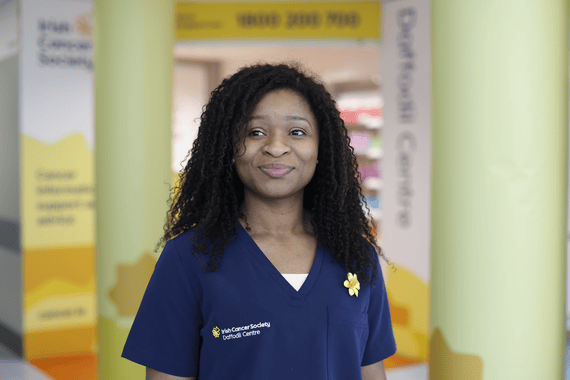Neuroendocrine tumours (NETs)
Diagnosis and tests
Diagnosing NETs
Your family doctor (GP) will talk to you about your symptoms. Your GP will refer you to hospital if they think you need more tests. Tests you might have include:
An X-ray of your chest can tell if there is anything abnormal about your lungs.
Doctors will take a sample of blood and check it for certain chemicals and hormones that might suggest you have a NET. These substances are called NET markers. Examples are chromogranin A and B, pancreatic polypeptides, insulin and gastrin. If the results of this test suggest the presence of a NET, you will have other tests, e.g. scans. The blood tests can also check how well your kidneys and liver are functioning.
A urine test is done to detect the levels of a substance called 5-HIAA. A higher-than-normal level of 5-HIAA may indicate a NET, although further tests are required to confirm the diagnosis. Your nurse will give you specific instructions to follow before collecting this urine sample.
Ultrasound scans use sound waves to build up a picture of the inside of the body. Read more about ultrasound scans.
This scan uses an injection of a drug called octreotide, which is similar to the hormone somatostatin. Many NET cells have strong receptors for somastostatin and will bind to the octreotide. The octreotide is attached to a radioactive substance which shows up the cells it binds to on a scan. In most cases this scan can show your doctors if there are any NET cells in your body and where they are.
Scoping tests such as gastroscopy (endoscopy), colonoscopy and EUS use a tube with a camera and a light attached which is passed into your body. Your doctor or nurse can see inside your body and check for any abnormal areas. Samples of tissue (biopsies) can also be taken during a scoping test.

If you are diagnosed with a NET, we're here for you.
Our cancer nurses are here if you need information or just want to talk. They can help you to understand your diagnosis and what to expect, send you information and tell you about our services.
Further tests
You may need further tests to give your doctors more information about your general health and about the cancer. For example:
This measures the level of a protein called chromogranin A (CgA) in the blood. It can be used to help diagnose NETs, as people with a NET may have a raised level of CgA. It can also be used to monitor how you are responding to treatment. This test needs to be put on ice when taken by the phlebotomist.
A test used for people with carcinoid syndrome. It measures a peptide in your blood which gives your team information about your heart function.
- Kidney function (urea and electrolytes)
- Liver function
- Thyroid function
- Pituitary hormones (e.g. adrenocorticotrophic hormone (ACTH), prolactin, growth hormones and cortisol)
- Serum calcium, parathyroid hormone levels (as a simple screening test for MEN-1 syndrome)
- Levels of other hormones
- Levels of vitamins and minerals
This test measures a substance called 5HIAA, which is found in the urine (pee) if your tumour is producing high levels of serotonin. this test can show the amount of serotonin in the body to confirm a diagnosis of carcinoid syndrome. It is also used to monitor patients with carcinoid syndrome.
For 24 hours, every time you pee you will collect it in a container and then you will return the urine to the hospital. The hospital will advise you on how to collect and store the urine. They will also advise you on foods and medicines to avoid before the test, as some can affect the results.
This is a type of X-ray that gives a detailed 3D picture of the tissues inside your body. It can show the position and size of tumours. You may have regular scans to find out more about the rate of tumour growth and how the tumour is responding to treatment.
A PET scan can show if the cancer has spread to other tissues and organs,
This a special type of PET scan that is more sensitive. This test can help reveal the size and position of NET tumours in the body. It can also show if your NET might respond to targeted treatments, such as PRRT or targeted drug treatments.
You may have to travel to a specialist centre to have a PET scan or a Gallium 68 scan, as not every hospital has these scanners. You will be slightly radioactive after the PET scan. You should avoid close contact with pregnant women, babies or young children for a few hours after the scan. Drink plenty of fluids and empty your bladder regularly after the scan; this can help flush the radiotracer from your body.
This is a scan that uses magnetic energy and radio waves to create a picture of the tissues inside your body. An MRI scan can be used to see where a tumour is. Further tests may be needed to confirm the type of tumour.
Endoscopy is a scoping test that looks inside your body. It often refers to a test that examines your upper digestive system (oesophagus, stomach, start of the small intestine). This can also be called a gastroscopy. The tube with the camera is inserted down the back of your throat.
Sometimes an ultrasound probe is attached to the tube inserted. This is called an EUS – endoscopic ultrasound. It can give a clearer view of the tumour and surrounding areas.
Samples of tissue (biopsies) can also be taken during a scoping test.
A colonoscopy looks at your large intestine (colon) and rectum. The tube with the camera is inserted into your back passage. Read more about colonoscopy
Taking a sample of the tumour using a fine needle. This may be done during a scoping test, where a tube is passed into your body. Sometimes this may be guided using ultrasound or another method to help ensure the targeted tumour is biopsied.
The sample is examined in a laboratory by a specialist called a histopathologist to give information about what type of NET cancer it is, and how it is growing.
This is a type of ultrasound scan, which uses sound waves to build up a picture of your heart.
A gel will be spread over the area the doctors are checking. A small device like a microphone is moved back and forth over your skin to take the scan. This can be used to check for heart issues which may occur due to carcinoid syndrome.
The tests you have can help to:
- Stage your cancer. This means finding out where the cancer is in your body – its size and if it has spread.
- Grade your cancer. Grading describes the cancer cells – what they look like under the microscope and how they might grow.
Some tests may be used see how you are responding to treatment.
Waiting for test results
It may take a few weeks to get all the test results. Waiting for results can be an anxious time. It may help to talk things over with your doctor or nurse or with a relative or close friend. You can also call our Support Line on 1800 200 700 or visit a Daffodil Centre to speak to a cancer nurse.
How are NETs staged?
Staging means finding out how big the cancer is and if it has spread to other parts of your body. Staging will help your doctor to plan the best treatment for you.
TNM staging system
The staging system normally used with NETs is called TNM. This stands for:
- Tumour (T): The size of the tumour
- Node (N): Is there cancer in your lymph nodes?
- Metastasis (M): Has the cancer has spread to other parts of your body?
Your doctor often uses this information to give your cancer a number stage – from 1 to 4. A higher number, such as stage 4, means a more advanced cancer, where the cancer has spread to other parts of your body.
Knowing the stage and grade of your cancer helps your team to plan the best treatment for you.
How are NETs graded?
Grading describes how quickly the cancer may grow and spread and how it might respond to treatment.
A special doctor called a pathologist looks at a tissue sample (biopsy) from the tumour under a microscope to see:
- How often the cells of the tumour are dividing (called the mitotic count)
- How much of a protein called Ki67 the cells make when they divide (Ki67 labelling index)
- The number of dead cells or tissues that are present (necrosis)
The pathologist gives the NET a grade from 1 to 3.
The cells of the tumour are slow growing (low grade). The Ki67 index is 2% or less.
The cells of the tumour are growing and dividing more quickly than normal cells. The Ki67 index is between 3% and 20%.
The cells of the tumour are growing quickly. These tumours are more likely to spread than grade 1 and grade 2 tumours. The Ki67 index is more than 20%.
Staging and grading can be hard to understand, so ask your doctor and nurse for more information if you need it. You can also talk to our cancer nurses by calling Freephone 1800 200 700.
Continue reading about Neuroendocrine tumours (NETs)




Get help & support

Support Line
Free support pack

